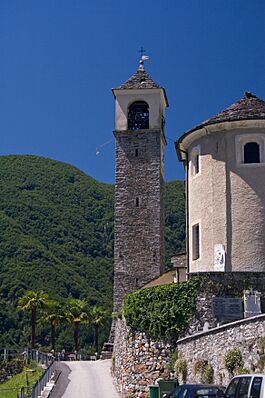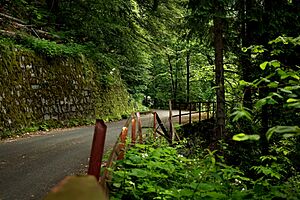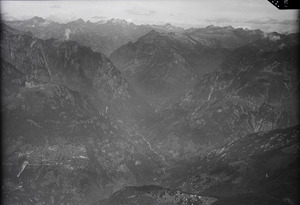Mergoscia facts for kids
Quick facts for kids
Mergoscia
|
||
|---|---|---|
 |
||
|
||
| Country | Switzerland | |
| Canton | Ticino | |
| District | Locarno | |
| Area | ||
| • Total | 12.17 km2 (4.70 sq mi) | |
| Elevation | 735 m (2,411 ft) | |
| Population
(Dec 2020 )
|
||
| • Total | 201 | |
| • Density | 16.52/km2 (42.78/sq mi) | |
| Postal code |
6647
|
|
| Surrounded by | Avegno, Brione sopra Minusio, Corippo, Gordevio, Gordola, Tenero-Contra, Vogorno | |
Mergoscia is a small town, also called a municipality, in the Locarno area of Ticino, a canton in Switzerland. It's a quiet place with a rich history and beautiful natural surroundings.
Contents
History of Mergoscia
Mergoscia was first mentioned in old writings in 1061. Back then, it was called Mergossia. Later, in 1300, it was known as Mergosia.
Early Village Life
In 1313, Mergoscia became separate from the Vicinanza of Minusio and Brione. A Vicinanza was like a local community group that shared land and resources. Even after splitting, Mergoscia continued to share most of its common land with the old Vicinanza until 1952.
To avoid paying a special tax called a tithe to the noble families of Locarno, the villagers decided to join the valley communities of Verzasca and Valle Maggia in the early 1400s.
Church and Community
The village church became independent from the main church in Locarno in 1591. The parish church of San Gottardo was built in 1597. It was built on the site of an even older church from 1338. The church's tall bell tower was added in 1697.
Work and Travel
Most people in Mergoscia used to be farmers, shepherds, or cattle herders. They practiced seasonal migration. This meant they moved their animals between high mountain pastures in summer and warmer valleys in winter. Until 1920, they even shared grazing land with Minusio and Locarno.
Because there wasn't much money to be made, many villagers left Mergoscia. They moved to other countries from the 1400s all the way to the 1800s. Getting to Mergoscia used to be hard. An old road was finally built in 1900. Later, a tunnel was added in 1997–98, making it much easier to reach the village. This easier access led to many houses becoming vacation homes.
Geography of Mergoscia

Mergoscia covers an area of about 12.14 square kilometers (4.69 square miles). A large part of this land, about 67.3%, is covered by forests. About 3.5% of the land is used for farming. A small part, 2.6%, has buildings or roads. Rivers and lakes make up 5.2% of the area. The remaining 10.3% is land that cannot be used for farming or building.
The town is located in the Locarno district. It sits above Lago di Vogorno, a beautiful lake, in the Verzasca Valley.
People of Mergoscia
Mergoscia has a population of about 218 people (as of 2022). About 9% of the people living there are from other countries. Over the past ten years, the number of people living in Mergoscia has grown by about 19.9%.
Languages Spoken
Most people in Mergoscia speak Italian, which is about 71.8% of the population. The second most common language is German, spoken by about 24.3% of the people. A small number, 2.2%, speak French.
Age Groups
In Mergoscia, about 8.7% of the population are children aged 0 to 9 years old. Teenagers, aged 10 to 19, make up about 11% of the population. Adults between 20 and 59 years old make up about 51% of the population. Older adults, aged 60 and above, make up about 29.4% of the population.
Homes and Households
In 2000, there were 84 private homes in Mergoscia. On average, each home had about 2.1 people living in it. Most of the buildings, about 95.2%, were single-family homes. Many of the apartments in Mergoscia are used as vacation homes. About 80.4% of the apartments are occupied only during certain seasons, while 19.6% are lived in all year round.
Population Changes Over Time
Here's how the population of Mergoscia has changed through the years:
| year | population |
|---|---|
| 1596 | 316 |
| 1790 | 752 |
| 1850 | 588 |
| 1900 | 351 |
| 1950 | 197 |
| 1990 | 133 |
| 2000 | 181 |
Economy of Mergoscia
In 2007, the unemployment rate in Mergoscia was about 2.67%. This means a small number of people who wanted to work couldn't find jobs.
Types of Jobs
Most jobs in Mergoscia are in the primary economic sector. This includes things like farming and forestry. In 2005, 18 people worked in this area, with 6 businesses. The secondary sector, which includes manufacturing and construction, had 2 people working in 2 businesses. The tertiary sector, which includes services like shops and tourism, had 8 people working in 3 businesses.
Many people who live in Mergoscia travel to other towns for work. In 2000, about 43 workers commuted out of the municipality. Most of them, about 55.6%, used a private car to get to work. A smaller number, 4.2%, used public transportation.
Religion in Mergoscia
Based on the 2000 census, most people in Mergoscia are Roman Catholic, about 71.3%. About 13.8% of the population belonged to the Swiss Reformed Church. A small group, about 11.05%, belonged to other churches not listed in the census.
Education in Mergoscia
Many adults in Mergoscia have a good education. About 78.1% of people aged 25 to 64 have finished either non-mandatory upper secondary education or even higher education, like university.
School System
In 2009, there were 36 students in Mergoscia. The education system in Ticino offers up to three years of non-mandatory kindergarten. In Mergoscia, 6 children were in kindergarten.
The primary school program lasts for five years. In Mergoscia, 11 students attended these primary schools. For lower secondary school, students can choose between a two-year middle school followed by a two-year pre-apprenticeship, or a four-year program to prepare for higher education. There were 15 students in the two-year middle school and 2 students in the four-year advanced program.
Upper secondary school prepares students for a trade or for university. In Ticino, students can learn a trade while working (an internship or apprenticeship) or study full-time. In Mergoscia, 1 student was a full-time vocational student, and 1 was part-time.
In 2000, 17 students from Mergoscia went to schools outside the municipality.
See also
 In Spanish: Mergoscia para niños
In Spanish: Mergoscia para niños







